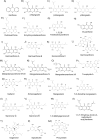Recent updates on metabolite composition and medicinal benefits of mangosteen plant
- PMID: 30755827
- PMCID: PMC6368837
- DOI: 10.7717/peerj.6324
Recent updates on metabolite composition and medicinal benefits of mangosteen plant
Abstract
Background: Mangosteen (Garcinia mangostana L.) fruit has a unique sweet-sour taste and is rich in beneficial compounds such as xanthones. Mangosteen originally been used in various folk medicines to treat diarrhea, wounds, and fever. More recently, it had been used as a major component in health supplement products for weight loss and for promoting general health. This is perhaps due to its known medicinal benefits, including as anti-oxidant and anti-inflammation. Interestingly, publications related to mangosteen have surged in recent years, suggesting its popularity and usefulness in research laboratories. However, there are still no updated reviews (up to 2018) in this booming research area, particularly on its metabolite composition and medicinal benefits.
Method: In this review, we have covered recent articles within the years of 2016 to 2018 which focus on several aspects including the latest findings on the compound composition of mangosteen fruit as well as its medicinal usages.
Result: Mangosteen has been vastly used in medicinal areas including in anti-cancer, anti-microbial, and anti-diabetes treatments. Furthermore, we have also described the benefits of mangosteen extract in protecting various human organs such as liver, skin, joint, eye, neuron, bowel, and cardiovascular tissues against disorders and diseases.
Conclusion: All in all, this review describes the numerous manipulations of mangosteen extracted compounds in medicinal areas and highlights the current trend of its research. This will be important for future directed research and may allow researchers to tackle the next big challenge in mangosteen study: drug development and human applications.
Keywords: Garcinia mangostana L.; Manggis; Medicine; Natural product; Pharmaceutical.
Conflict of interest statement
The authors declare that they have no competing interests.
Figures


Similar articles
-
Recent Update on Active Biological Molecules in Generating the Anticancerous Therapeutic Potential of Garcinia mangostana.Appl Biochem Biotechnol. 2022 Oct;194(10):4724-4744. doi: 10.1007/s12010-022-04031-2. Epub 2022 Jul 19. Appl Biochem Biotechnol. 2022. PMID: 35852758 Review.
-
Medicinal properties of mangosteen (Garcinia mangostana L.): A comprehensive update.Food Chem Toxicol. 2017 Nov;109(Pt 1):102-122. doi: 10.1016/j.fct.2017.08.021. Epub 2017 Aug 24. Food Chem Toxicol. 2017. PMID: 28842267 Review.
-
Valorization of mangosteen, "The Queen of Fruits," and new advances in postharvest and in food and engineering applications: A review.J Adv Res. 2019 May 29;20:61-70. doi: 10.1016/j.jare.2019.05.005. eCollection 2019 Nov. J Adv Res. 2019. PMID: 31210985 Free PMC article. Review.
-
A metabolomics-based approach for the evaluation of off-tree ripening conditions and different postharvest treatments in mangosteen (Garcinia mangostana).Metabolomics. 2019 May 3;15(5):73. doi: 10.1007/s11306-019-1526-1. Metabolomics. 2019. PMID: 31054000
-
Biological activities and bioavailability of mangosteen xanthones: a critical review of the current evidence.Nutrients. 2013 Aug 13;5(8):3163-83. doi: 10.3390/nu5083163. Nutrients. 2013. PMID: 23945675 Free PMC article. Review.
Cited by
-
Cytotoxic Effects of Mangosteen Pericarp Extracts on Oral Cancer and Cervical Cancer Cells.Asian Pac J Cancer Prev. 2020 Sep 1;21(9):2577-2583. doi: 10.31557/APJCP.2020.21.9.2577. Asian Pac J Cancer Prev. 2020. PMID: 32986355 Free PMC article.
-
Metabolic syndrome; Definition, Pathogenesis, Elements, and the Effects of medicinal plants on it's elements.J Diabetes Metab Disord. 2022 Mar 15;21(1):1011-1022. doi: 10.1007/s40200-021-00965-2. eCollection 2022 Jun. J Diabetes Metab Disord. 2022. PMID: 35673459 Free PMC article. Review.
-
Mitochondrial genome of Garcinia mangostana L. variety Mesta.Sci Rep. 2022 Jun 8;12(1):9480. doi: 10.1038/s41598-022-13706-z. Sci Rep. 2022. PMID: 35676406 Free PMC article.
-
Bioactive xanthones, benzophenones and biphenyls from mangosteen root with potential anti-migration against hepatocellular carcinoma cells.Sci Rep. 2022 May 21;12(1):8605. doi: 10.1038/s41598-022-12507-8. Sci Rep. 2022. PMID: 35597781 Free PMC article.
-
The Beneficial Effect of Eco-Friendly Green Nanoparticles Using Garcinia mangostana Peel Extract against Pathogenicity of Listeria monocytogenes in Female BALB/c Mice.Animals (Basel). 2020 Mar 29;10(4):573. doi: 10.3390/ani10040573. Animals (Basel). 2020. PMID: 32235366 Free PMC article.
References
-
- Abdul-Rahman A, Suleman NI, Zakaria WA, Goh HH, Noor NM, Aizat WM. RNA extractions of mangosteen (Garcinia mangostana L.) pericarps for sequencing. Sains Malaysiana. 2017;46(8):1231–1240. doi: 10.17576/jsm-2017-4608-08. - DOI
-
- Agrippina WRG, Widiyanti P, Yusuf H. Synthesis and characterization of bacterial cellulose-Garcinia mangostana extract as anti breast cancer biofilm candidate. Journal of Biomimetics, Biomaterials and Biomedical Engineering. 2017;30:76–85. doi: 10.4028/www.scientific.net/jbbbe.30.76. - DOI
-
- As’ari H, Asnani DMM. The effect of administering mangosteen rind extract Garciana mangostana L. to decrease the low density lipoprotein (LDL) serum level of a white male rat with hypercholesterolemia. Dama International Journal of Researchers. 2017;2:57–60.
-
- Aukkanimart R, Boonmars T, Sriraj P, Sripan P, Songsri J, Ratanasuwan P, Laummaunwai P, Boueroy P, Khueangchaingkhwang S, Pumhirunroj B. In vitro and in vivo inhibitory effects of α-mangostin on cholangiocarcinoma cells and allografts. Asian Pacific Journal of Cancer Prevention. 2017;18:707–713. - PMC - PubMed
LinkOut - more resources
Full Text Sources
Molecular Biology Databases

